Starting from 3 years old, children have better self-awareness and communication skills. They would understand others better and acquire basic social skills such as being polite, sharing and taking turns. At the beginning, they still need you to remind them of the social skills. With time, they will get better at them. At home, they will create imaginary friends. While learning with other children at kindergarten, they will gradually understand the importance of obeying rules and getting along with others.
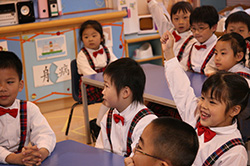
Imaginary Friends
It is common for children to have imaginary friends before they are 4 years old. These friends can be an imaginary child, animal or a stuffed toy. Your child can learn about different social circumstances under a safe environment as your child would treat them as friends, protectors or even punching bags, allowing them to learn to deal with different social situations under a safe setting. That will help children to think, adjust their emotions and develop fundamental social skills which can be applied in daily life.
Understand Your Child's Feelings through Imaginary Friends
Your child may project her feelings and thoughts onto her imaginary friends, so be attentive to what she says to her imaginary friend. e.g. you may learn that your child is afraid of seeing the doctor when she is comforting her stuffed doggie on the way to the clinic.
To help your child to understand the matter and encourage her to express herself, talk to the toy directly, “Doggie doesn't want to see the doctor. Is she afraid of getting the shot? Having the shot is actually easy and fast. Yes, brave doggie!”
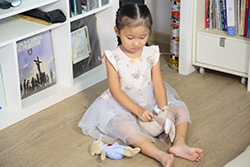

Foster Desirable Behaviours through Imaginary Friends
Make use of imaginary friends to be the role model and motivation for your child's desirable behaviours.
- Example 1: When your child resists taking a shower, tell him, “Molly takes a shower every day. Molly won't play with you if you are dirty and smelly.”
- Example 2: When your child resists eating fruit or vegetables, you may give some to the doll and say, “Although Dollie hasn't tried any carrots before, she wants some too. It tastes good Dollie, doesn't it?”
Group Activities
After your child enters kindergarten, his social circle is extending while he participates in more group activities. He will learn new things and make new friends. Unlike his imaginary friends, his peers can think, feel and have their own preferences. Your child may choose his own peer group based on his own character. Nevertheless, conflicts may still arise with his friends.

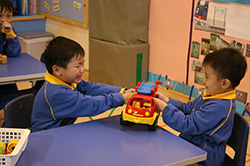
The child who participates more actively is usually the leader among a group. He will take care of other children and set up rules for them to follow. The active and confident ones are the entertainers. Sometimes, they may speak aloud unintentionally when they feel excited or want to make fun. Most of the children will be the followers. They will pick the group that suits them which could be quiet or active.
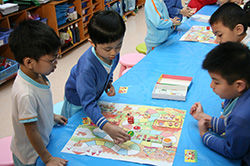
Every child is unique. You may remind them some social rules according to their characteristics and let them explore freely without intruding on others. Your child will be happy to get along with her peers.
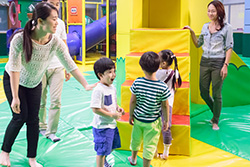

- If your child complains about conflicts with other children, do listen to her so that she feels she is being understood and can have a chance to learn to express and accept her own feelings.
- Don't be judgmental or take side. Keep in mind that short-lived conflicts are common for children of this age. You need not worry too much.
- When your child has negative emotions, don't jump to conclusion or criticise her with words like “silly you” or “I don't want to talk to you”.
- Stay in contact with the teacher to understand your child's needs and work together to manage her emotion and behaviour.
- Don't question your child too much about her friends and make her feel stressed. Accept her personality and characteristics and let her make friends at her own pace.
- Use dolls or stuffed toys to role play different social circumstances. Guide your child to think of different solutions and find out the most appropriate one.
- If your child is shy, you can invite one or two of her classmates over after school or during weekends. Therefore, you child can learn to communicate with others in a familiar environment.
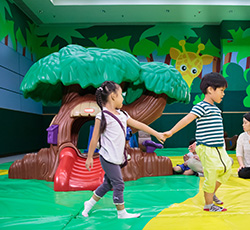
FAQs on Getting Along with Friends
My child is very shy, what can I do?
Some children are quiet and introverted. They need more time to get used to strangers. Instead of pressing or forcing him, try to understand and accept her characteristics. Guide her step-by-step with patience to join in other children's activity.

- Stay with her while watching other children play.
- Show her how to join in other children's play by doing it.
- Invite her to join in when she is ready.
- Do not blame or shame her if she refuses to join. Show your acceptance by saying “I know you prefer to watch a little longer. When you want to play with them, just let me know.”
- If your child joins in, wait till she becomes more involved in the activity before you gradually withdraw. Yet, stay close and give her encouragement from time to time.
My child is not willing to take turns, what can I do?
- When your child is queuing up, talk with her to divert her attention.
- Tell her beforehand for how long she can play.
- Before the game ends, prepare your child in advance: “Time is nearly up. Please give turn to the next kid after I count to 10.”
- Use your imagination to help your child end the game more pleasantly: “It's time for the car to go home. Hurry to park it!”
- Tell your child that there are other more interesting toys/games “Look! These blocks are so pretty!”
- If your child is unwilling to give up the toy or game, accept her feelings, “You really like this bike and want to play a bit longer, right?”. Then lead her to take turns, “Let's queue up again.” You can also offer other choices, “How about playing with the blocks?”
- If your child does not follow the rules, take her aside. Let her quiet down for a minute and do not give her any attention. After the one minute, let her join the game again and remind her to follow rules.

My child grabs others' toys, what can I do?
- Children may fight for toys. It does not mean that they are bullies. Rather, they have not yet learnt to solve problems, and to understand others' thoughts and feelings. You may show your child how to share with visitors or when visiting friends.

- Discuss with your child which toys she can share. Put away those she does not want to share.
- When visiting friends, ask your child to bring along one or two toys that she can share.
- Before asking your child to share, explain to her that she is just lending out the toy for a while, and it will be returned later. “How about letting your friend plays with the toy for a while. He will return it to you when we go home.”
- Praise her immediately if she agrees to share.
- If problem arises, you may stand aside to observe your child's interactions with peers before deciding to step in. Do not judge too early and favour either side:
- If your child had grabbed a toy from another child, step in and stop her immediately.
Guide her to think about different solutions,
- “If you want to play it, what should you do? You can ask for it nicely.”
- “You can either exchange your toy for it, or take turns.”
- If your child had grabbed a toy from another child, step in and stop her immediately.
- If your child is upset when she failed to grab the toy, show her that you understand her feelings and guide her to think of other ways,
“You are upset because she did not let you play that toy, right? But that's her toy. She will be upset too if you grab it.”
- If others agree to lend her the toy, teach her to say “thank you”. Otherwise, try to divert her attention to other toys or games.
My child always hits others, what can I do?
Children often fight to solve problems. They may also become aggressive when they are frustrated or angry. Proper guidance can prevent your child's aggressive behaviour developing into a habit, help her solve problems in acceptable ways, and let her learn to be responsible for her aggressive behaviour.
- Set 2 to 3 rules with your child about playing with others, such as “take turns”, “be kind”. State clearly the consequences for breaking the rules, for example “have the toy taken away for 1 minute”.
- When you child plays peacefully with others, praise her more.
- If she hits others, stop her at once: “Stop! You are hurting him. If you want to play, you have to take turn.”
-
If she does not stop, lead her aside and let her calm down for one minute. Do not give her any attention meanwhile. After quieting down for one minute, let her join the game again and remind her to follow the rules.
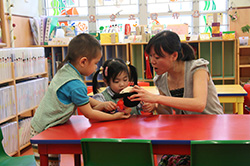
- You may then lead her to say sorry and make peace with the other child.

